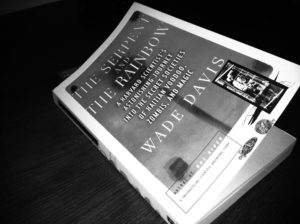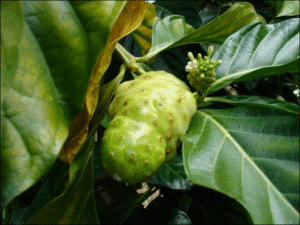by Nora Connor
In its October issue Harper’s* revisits the zombie phenomenon–the Haitian kind, that is, not the George Romero kind. Which, come to think of it, makes it a bit of a strange Halloween selection. Journalist Hamilton Morris did his reporting pre-earthquake; the social feature most representative of Haiti’s practical difficulties is an excess of burning plastic garbage, a result of dysfunctional or nonexistent collection. It’s as if Harper’s were running a time capsule piece, giving us a brief glimpse of pre-Year Zero Haiti.
Morris’s piece is also an exercise in the policing of genre boundaries within academic and journalistic endeavors. At least since the mid-1980s, when anthropologist/ethnobotanist Wade Davis published The Serpent and the Rainbow, where there are Haitian Zombies, there are drugs. Davis took the social fact of zombification as a given and attempted to identify the chemical element in the sorcerers’ powder that makes the process, understood as magical or supernatural, “scientifically” possible. He may or may not have found it—TTX, a toxin from the organs of puffer fish that causes temporary paralysis—and gained no small amount of notoriety in the meantime. Scientists jumped on his science, anthropologists shredded his anthropology, historians disputed his history.
Davis was accused of violating the ethical standards of a number of disciplines: he paid for his drug samples, did not report the results of tests unfavorable to his preferred conclusions, participated in (enabled by his presence?) the exhuming of a child’s body, and by some lights amplified a racist narrative of Haitians as primitive and superstitious. What does seem clear, at least from Morris’s article which includes an interview with Davis, is that Davis viewed his botanist-ethnographer enterprise as additive to the study of the zombie phenomenon: he discovered and expressed a possible scenario, with scientific evidence that was suggestive, but couldn’t be considered conclusive. The main disciplines he engaged were hostile to his work possibly or partially because it wasn’t fully intelligible within any of them. Even today it’s frustrating that the terms of debate –science or magic, medicine or religion–remain so untranslatable.
Morris’ interview with Davis and his reporting trip to Haiti happened in the context of making a documentary for Vice Magazine. He’s Vice’s “Pharmacopeia Correspondent,” an apotheosis if ever there was one. His articles have covered such things as cooking DMT, meth lab explosions and the most addictive forms of synthetic opioids; he has at least a committed, self-taught level of pharmacological expertise. Yet his authorial tone (and in the documentary, his voice-over narration) is so solidly wrapped in the protective Vice cocoon of all-encompassing ironic distance that I wondered for a while if the whole thing—his interest in Davis’ work, his interest in zombie powder, his knowledge of chemistry—was a put-on. This is a genre problem in itself.
Morris shares Davis’ pharmacological interest in zombification. And he’s well aware of the trap that Davis ran across—what he calls “the strange sensitivity encountered when one provides scientific evidence for phenomena once considered to be purely supernatural.” Noting that no significant scientific research on zombies has followed Davis’, he sets out to “revive” it, aiming to collect more powder samples for analysis.
He’s mindful of, though far less interested in, Davis’ concept of zombification as a chemical event that happens within a cultural or belief matrix. And he’s refreshingly uninterested in a search for an “authentic” Voodoo. He wants the drugs, and doesn’t find them—finds less of them than Davis did, in fact. The powder he buys, after haggling the price down from $50,000 to about $1,000, turns out upon inspection back in New York to contain no active ingredients at all, and he even consumes a haphazardly prepared puffer fish with neither intoxicating nor poisonous results. He can’t even find the plants supposedly used.
When he asks to see a zombie cucumber—a plant of the Datura genus thought to be an ingredient in zombie powder—he’s handed a specimen from another genus. “I would say it was an honest mistake,” Morris writes, “except M. citrifola is widely believed to cure AIDS throughout the tropics, and so the circuit of confusion is complete.” Morris doesn’t confront the man about the error, but clearly feels it’s likely his source knew exactly which plant he was pointing out. Was this source putting him on, then? Was the informant simply handing him a plant in order to please, assuming botanical ignorance on the part of the American journalist? Or, in the absence of zombie cucumber, might he have chosen the most readily available powerful plant? It’s hard to tell. Zombification is considered poisoning under Haitian law and is illegal—adding a potentially serious obstructive ingredient to the stew of motivations on display by Morris’s sources. Maybe they were just stonewalling.
What Morris most effectively ends up showing the reader and the viewer is what he describes in the Harper’s story as “the line between ancient tradition and tourist skullduggery… how does one distinguish between authentic Voodoo and, well, voodoo Voodoo?” Everyone marshaled into service on Morris’s quest is performing, with motives that appear to range from a desire to “help,” to a desire to profit, to a desire to advance or exhibit a personal expertise in zombification.
Alex, Morris’s driver and translator, has strong opinions about both zombies (informing Morris, for example, that zombies can be pressed into service doing Excel spreadsheets nowadays) and the talents of the various bokors (translated as both “sorcerer” and “priest,” some of whom reportedly perform zombification) he arranges for Morris to meet. In one great scene, Morris and Alex return for an appointment with Thomas, a bokor whom Morris has agreed to pay to watch the preparation of zombie powder. Alex dislikes or distrusts Thomas—the two argue about the potential for zombies to assume various animal characteristics–and Thomas ultimately backs out of the deal.
Something’s gone wrong between the translator, one type of expert, and the bokor, another type, and the agreement to produce for the journalist falls through. What was the conflict about, exactly? We can’t be sure, witnessing it as we do through Morris’s telling, who after all is relying on both of them for a kind of translation. It’s interesting to watch this play out, but it’s ultimately more suggestive than descriptive. The two Haitians may have been disagreeing about a point of Voodoo; they may have had a conflict relating to their mutual interest in the exchange with Morris; they may have simply disliked each other. Morris wryly describes their exchange (thanks to a translation/transcription made for the documentary) without really evaluating it. Perhaps he viewed it as incidental to his goal of chemical discovery—yet it reminds us how socially loaded such attempts really are.
I did wonder if Morris’s lack of interest (or it might be an excess of caution) regarding what Davis called “the cultural matrix”—here, the religious context of Voodoo—might have hampered his progress. After interviewing Max Beauvoir, a Voodoo priest and biochemist, Morris makes an interesting observation. Beauvoir has explained that zombification is a way of neutralizing destructive behaviors within the community. Yet Morris pulls this practice out of a religious context, writing that zombification “is not exactly a religious act, or a legal one, but something closer to involuntary psychiatric treatment…despite its superficial grisliness, the place zombification holds… is strikingly similar to that of antipsychotic drugs in Western psychiatry.” The analogy is potentially insightful. Without further exploration in the Voodoo context, though, it doesn’t add much to the article aside from illuminating Morris’ own intellectual interests.
* Subscription only.
Nora Connor is a filmmaker and multimedia journalist with a background in labor and human rights organizing. She studied religion and anthropology at Columbia and journalism at NYU. She is the 2011 Luce Fellow in International Digital Religion at The Center for Religion and Media/The Revealer.




